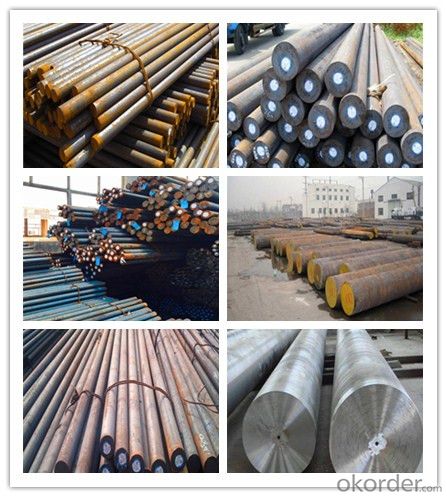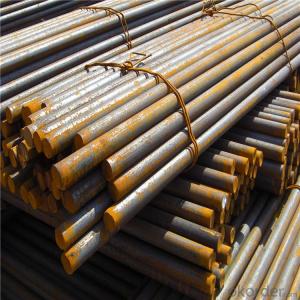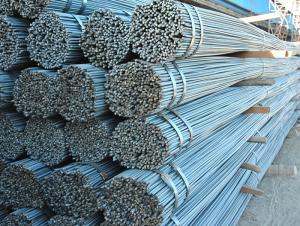SAE1040 Forged Steel Bar
- Loading Port:
- Tianjin
- Payment Terms:
- TT OR LC
- Min Order Qty:
- 100 m.t.
- Supply Capability:
- 500000 m.t./month
OKorder Service Pledge
OKorder Financial Service
You Might Also Like
Item specifice
SAE1040 Forged Steel Bar
Product Description of SAE1040 Forged Steel Bar
1. Steel grade: SAE1040, 40#, C40, S40C
2. Length: 6M-12M
3. Diameter: 16mm-300mm
4. Product range: round bar, flat bar, square bar
5. Technique: Hot rolled, forged, cold drawn
Specification of SAE1040 Forged Steel Bar
Material | SAE1040 | Round bar | Dia(mm) | 16-300mm |
Process | EAF + LF + VD + Forged + Heat Treatment (optional) | Length (mm) | Max 12m | |
Heat treatment | Normalized / Annealed / Quenched / tempered | Flat bar | Thickness(mm) | 8-500mm |
Delivery condition | Hot forged +Rough machined (black surface after Q/T)+ Turned (optional) | Width(mm) | 70-200mm | |
Test | Ultrasonic test according to SEP 1921-84 D/d | Length (mm) | Max 12m |
Chemical Composition of SAE1040 Forged Steel Bar
C | Si | Mn | Cr | Ni | Cu |
0.37~0.43 | 0.17~0.37 | 0.35~0.65 | ≤0.25 | ≤0.30 | ≤0.25 |
Photo Show of SAE1040 Forged Steel Bar

Packing and Delivery:
Packing in bundle package, or as customer's requirements.
Delivery Detail: 45 days after receiving the deposit.
Usage and Applications of SAE1040 Forged Steel Bar
1. Steel round bar is used in a large number of architectural and engineering structures. Or it can be used in construction of plants for the production of steel house frames, high-voltage transmission towers, bridges, vehicles, boilers, containers, ships, etc.
2. And we can use this kind of product on the performance of the mechanical parts if the demand is not very high.
3. Some special material steel round bar can be used for main shaft of steamer, hummer shank, with big section and supper force.
Company Information
CNBM International Corporation is the most important trading platform of CNBM group.
Whith its advantages, CNBM International are mainly concentrate on Cement, Glass, Iron and Steel, Ceramics industries and devotes herself for supplying high qulity series of refractories as well as technical consultancies and logistics solutions.


F A Q
1, Your advantages?
professional products inquiry, products knowledge train (for agents), smooth goods delivery, excellent customer solution proposale
2, Test & Certificate?
SGS test is available, customer inspection before shipping is welcome, third party inspection is no problem
3, Factory or Trading Company?
CNBM is a trading company but we have so many protocol factories and CNBM works as a trading department of these factories. Also CNBM is the holding company of many factories.
4, Payment Terms?
30% TT as deposit and 70% before delivery.
Irrevocable L/C at sight.
5, Trading Terms?
EXW, FOB, CIF, FFR, CNF
6, After-sale Service?
CNBM provides the services and support you need for every step of our cooperation. We're the business partner you can trust.
For any problem, please kindly contact us at any your convenient time.
We'll reply you in our first priority within 24 hours.
- Q:How do you calculate the weight of a steel round bar based on its volume and density?
- To calculate the weight of a steel round bar based on its volume and density, you can use the formula: weight = volume x density.
- Q:What is the difference between a cold finished and a turned steel round bar?
- Cold finished steel round bars and turned steel round bars are utilized in various industries for different purposes. The manufacturing process and resulting properties distinguish these two types of steel bars. For a cold finished steel round bar, the production involves cold drawing or cold rolling a hot rolled steel bar. This entails passing the hot rolled bar through a series of dies at room temperature, which decreases its diameter and increases its length. Through the cold drawing process, the steel acquires specific mechanical properties, including enhanced surface finish, dimensional accuracy, and increased strength. Cold finished steel bars possess a sleek, glossy surface and are renowned for their precise tolerances and consistent size and shape. They find common usage in applications requiring precision and high-quality surface finish, such as the automotive, aerospace, and machining industries. Conversely, a turned steel round bar is created by machining a hot rolled or cold finished bar on a lathe. The bar is secured and rotated while a cutting tool eliminates material from its outer surface, resulting in the desired shape and dimensions. This turning process yields a bar with a rougher surface compared to a cold finished bar. However, it enables faster production and versatility in creating diverse shapes and sizes. Turned steel bars are frequently employed in applications where the surface finish is not crucial but machining operations are necessary, such as in the construction, engineering, and manufacturing industries. In conclusion, the distinction between a cold finished and a turned steel round bar lies in the manufacturing process and the resulting properties. Cold finished bars are produced through cold drawing or cold rolling, leading to improved dimensional accuracy, surface finish, and strength. Turned bars are machined on a lathe, providing flexibility in shape and size but with a rougher surface finish. The choice between the two depends on the specific requirements of the application, including tolerance, surface finish, strength, and machinability.
- Q:What are the advantages of using nickel-alloy steel round bars?
- Nickel-alloy steel round bars offer numerous benefits: 1. Superior strength and durability: Renowned for their exceptional strength and durability, nickel-alloy steel round bars can endure high levels of stress and boast excellent corrosion resistance. Consequently, they are ideal for use in demanding environments. 2. Impressive temperature resistance: With their remarkable temperature resistance properties, nickel-alloy steel round bars retain their strength and integrity even in elevated temperatures. This renders them suitable for applications in industries such as aerospace, power generation, and petrochemicals. 3. Exceptional corrosion resistance: Nickel-alloy steel round bars exhibit outstanding resistance to rust and oxidation, making them highly resistant to corrosion. This quality makes them perfect for deployment in marine environments, chemical plants, and other settings where exposure to corrosive substances is common. 4. Excellent mechanical properties: Boasting outstanding mechanical properties like high tensile strength, toughness, and ductility, nickel-alloy steel round bars can withstand heavy loads and impacts without deformation or failure. As a result, they prove suitable for use in critical structural applications. 5. Versatility and adaptability: Nickel-alloy steel round bars are easily machinable, forgeable, and weldable, offering increased versatility in manufacturing processes. They can be shaped and formed into various sizes and dimensions to meet specific requirements, making them highly adaptable to different industries. 6. Cost-effective solution: Despite their initial higher cost compared to other materials, nickel-alloy steel round bars prove to be a cost-effective choice in the long run. Their resistance to corrosion and wear minimizes maintenance and replacement expenses, resulting in significant cost savings over time. In conclusion, the advantages of nickel-alloy steel round bars lie in their superior strength, impressive temperature resistance, exceptional corrosion resistance, excellent mechanical properties, versatility, adaptability, and cost-effectiveness. These qualities establish them as reliable and efficient options for numerous applications across various industries.
- Q:What are the different types of steel round bar surface treatments for improved wear resistance?
- There are several different types of steel round bar surface treatments that can be applied to improve wear resistance. These treatments are designed to enhance the hardness, toughness, and overall durability of the steel, making it more resistant to wear and corrosion. Some of the most common surface treatments for steel round bars include: 1. Nitriding: This treatment involves exposing the steel to a nitrogen-rich environment at high temperatures. This forms a hard nitride layer on the surface, which improves wear resistance and provides enhanced hardness. 2. Carburizing: Carburizing is a process that involves introducing carbon into the surface of the steel to create a high-carbon layer. This layer increases hardness and wear resistance, making it suitable for applications that require high strength and durability. 3. Induction hardening: Induction hardening is a heat treatment process that selectively hardens the surface of the steel. This is achieved by heating the steel using an induction coil and then rapidly quenching it. The resulting hardened layer provides excellent wear resistance while maintaining the toughness of the core. 4. Shot peening: Shot peening involves bombarding the steel surface with small metal or ceramic particles at high velocity. This process creates compressive stresses on the surface, which improves fatigue life and wear resistance. 5. Thermal spraying: In thermal spraying, a coating material is melted and sprayed onto the steel surface using a flame or plasma torch. This creates a protective layer that offers enhanced wear resistance and corrosion protection. 6. PVD/CVD coatings: Physical Vapor Deposition (PVD) and Chemical Vapor Deposition (CVD) coatings involve depositing a thin layer of material onto the steel surface. These coatings provide excellent wear resistance, low friction, and improved corrosion protection. 7. Hard chrome plating: This process involves electroplating a layer of chromium onto the steel surface. Hard chrome plating offers high hardness, wear resistance, and corrosion protection. It's important to note that the choice of surface treatment depends on the specific application requirements and the type of wear resistance needed. Each treatment has its own advantages and limitations, and it is crucial to consider factors such as cost, environmental impact, and performance characteristics when selecting the most suitable treatment for a given steel round bar.
- Q:What are the different types of steel alloys used for round bars?
- There are various types of steel alloys used for round bars, including carbon steel, stainless steel, alloy steel, tool steel, and high-speed steel. Each type has unique properties and characteristics that make it suitable for different applications. Carbon steel is widely used for its strength and affordability, while stainless steel offers excellent corrosion resistance. Alloy steel is known for its durability and versatility, while tool steel is specifically designed for cutting and shaping tools. High-speed steel is used for its ability to withstand high temperatures and retain its hardness.
- Q:Are steel round bars suitable for high-temperature applications?
- Steel round bars can be suitable for high-temperature applications depending on the specific grade and composition of the steel. Certain grades of steel, such as stainless steel or heat-resistant alloys, are specifically designed to withstand high temperatures without losing their mechanical properties. These steel grades have high melting points, excellent heat resistance, and good oxidation resistance, making them ideal for applications in industries such as aerospace, automotive, and power generation. Stainless steel round bars, for example, exhibit excellent corrosion resistance and high strength at elevated temperatures. They can withstand temperatures up to 800-900 degrees Celsius without significant loss of mechanical properties. Additionally, heat-resistant alloys like Inconel or Hastelloy are used in extreme high-temperature environments, such as gas turbines or petrochemical plants, where temperatures can exceed 1000 degrees Celsius. However, not all steel round bars are suitable for high-temperature applications. Carbon steels, for instance, are prone to oxidation and loss of strength at elevated temperatures. Low-grade steel round bars may also experience deformation, softening, or even failure under high-temperature conditions. Therefore, it is crucial to select the appropriate steel grade and consult with experts or engineers to determine the suitability of steel round bars for specific high-temperature applications.
- Q:Can steel round bars be used in the manufacturing of cylinders?
- Yes, steel round bars can be used in the manufacturing of cylinders. Steel round bars are commonly used in various industries, including automotive, aerospace, and manufacturing, due to their high strength and durability. In the case of manufacturing cylinders, steel round bars can be a suitable material choice for constructing the cylindrical body of the cylinder. The steel round bars can be machined, forged, or rolled into the desired shape and then welded or fastened together to form the cylindrical structure. The use of steel round bars ensures a strong and sturdy construction, which is essential for the safe and efficient functioning of cylinders in various applications.
- Q:What is the difference between a cold finished and a turned steel round bar?
- A cold finished steel round bar and a turned steel round bar are both types of steel bars used in various industries for different applications. The main difference between the two lies in the manufacturing process and the resulting properties of the bars. A cold finished steel round bar is produced by cold drawing or cold rolling a hot rolled steel bar. This process involves passing the hot rolled bar through a series of dies at room temperature, which reduces its diameter and increases its length. The cold drawing process imparts specific mechanical properties to the steel, such as improved surface finish, dimensional accuracy, and increased strength. Cold finished steel bars have a smooth, shiny surface and are known for their close tolerances and uniformity in size and shape. They are commonly used in applications where precision and high-quality surface finish are essential, such as in the automotive, aerospace, and machining industries. On the other hand, a turned steel round bar is made by machining a hot rolled or cold finished bar on a lathe. The bar is clamped and rotated while a cutting tool removes material from its outer surface, creating the desired shape and dimensions. This turning process results in a bar with a rougher surface compared to a cold finished bar, but it allows for faster production and versatility in creating various shapes and sizes. Turned steel bars are often used in applications where the surface finish is not critical and machining operations are required, such as in the construction, engineering, and manufacturing industries. In summary, the difference between a cold finished and a turned steel round bar lies in the manufacturing process and the resulting properties. Cold finished bars are produced through cold drawing or cold rolling, resulting in improved dimensional accuracy, surface finish, and strength. Turned bars are machined on a lathe, offering versatility in shape and size but with a rougher surface finish. The choice between the two depends on the specific requirements of the application, including tolerance, surface finish, strength, and machinability.
- Q:How do steel round bars perform in high-pressure applications?
- Steel round bars are known for their exceptional strength and durability, making them highly suitable for high-pressure applications. When subjected to high-pressure conditions, steel round bars exhibit excellent resistance to deformation and maintain their structural integrity. This enables them to withstand the intense forces and maintain their shape, ensuring the safety and reliability of the application. Steel round bars are often used in high-pressure applications such as hydraulic systems, oil and gas pipelines, aerospace components, and high-pressure vessels. Their robust nature allows them to handle the extreme pressures experienced in these applications without failure. The high tensile strength of steel ensures that the bars do not buckle or collapse under pressure, providing the necessary support and stability required for such demanding environments. Additionally, steel round bars possess excellent corrosion resistance properties, which is crucial in high-pressure applications. They can withstand exposure to harsh chemicals, moisture, and other corrosive elements, preventing rusting or degradation over time. This corrosion resistance ensures the longevity and reliability of the steel round bars in high-pressure environments, reducing the risk of premature failure. Furthermore, steel round bars offer versatility in terms of grades and alloys, allowing for customization to meet specific high-pressure requirements. Different grades of steel, such as carbon steel, alloy steel, or stainless steel, can be utilized based on the application's demands. This versatility ensures that the steel round bars can be tailored to provide optimal performance and meet the specific pressure and temperature requirements of the application. In conclusion, steel round bars excel in high-pressure applications due to their exceptional strength, durability, and corrosion resistance properties. Their ability to withstand intense forces and maintain their shape makes them a reliable choice for various industries, including hydraulic systems, oil and gas pipelines, aerospace, and high-pressure vessels. By utilizing steel round bars, companies can ensure the safety, reliability, and longevity of their high-pressure applications.
- Q:What are the advantages of using alloy steel round bars?
- There are several advantages of using alloy steel round bars. Firstly, alloy steel has superior strength and hardness compared to regular steel, making it more durable and resistant to wear and tear. Secondly, alloy steel round bars offer excellent corrosion resistance, making them suitable for use in various environments, including marine and chemical industries. Additionally, alloy steel can withstand high temperatures, making it ideal for applications that involve heat or extreme conditions. Lastly, alloy steel round bars can be easily machined and fabricated, allowing for versatility in design and customizations.
1. Manufacturer Overview |
|
|---|---|
| Location | |
| Year Established | |
| Annual Output Value | |
| Main Markets | |
| Company Certifications | |
2. Manufacturer Certificates |
|
|---|---|
| a) Certification Name | |
| Range | |
| Reference | |
| Validity Period | |
3. Manufacturer Capability |
|
|---|---|
| a)Trade Capacity | |
| Nearest Port | |
| Export Percentage | |
| No.of Employees in Trade Department | |
| Language Spoken: | |
| b)Factory Information | |
| Factory Size: | |
| No. of Production Lines | |
| Contract Manufacturing | |
| Product Price Range | |
Send your message to us
SAE1040 Forged Steel Bar
- Loading Port:
- Tianjin
- Payment Terms:
- TT OR LC
- Min Order Qty:
- 100 m.t.
- Supply Capability:
- 500000 m.t./month
OKorder Service Pledge
OKorder Financial Service
Similar products
New products
Hot products
Related keywords


































